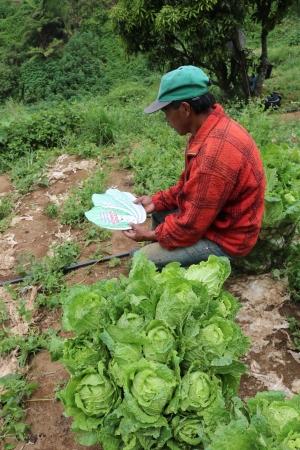Before cabbages are displayed on the isles of our local supermarkets, all wrapped up in a thin sheet of plastic, chilled, and tagged with a seemingly expensive price per piece, cabbages had to undergo a number of postharvest handling steps for it to get from farm to final display.

This entire process of handling harvested cabbage puts a lot of stress to the commodity, ultimately affecting its size. Most consumers who only get their produce at the supermarket are generally unaware that a piece of purchased cabbage could have bought them an entire sack of the same produce at a farm level, what makes the produce more expensive are the costs that cover the commodity’s journey to the dining table.
Wombok, pechay or Chinese cabbage, is a leafy vegetable commonly used in cooking Filipino dishes like pansit and bulalo. It’s also the main ingredient of kimchi, a Korean staple that Filipinos have learned to love.
Despite being a common ingredient for a lot of Asian dishes, Chinese cabbage is a commodity that sheds a lot of its leaves when handled improperly. “Nang dahil sa hindi tamang pag-handle ng ating commodity ang nangyayari ay nasisira ito, ito ay nagiging ‘loss’ na. ‘Loss’ sa magiging produkto at ‘loss’ doon sa income ng mga farmers,” explained Dr. Perlita A. Nuevo of the Postharvest Horticulture and Research Center (PHTRC), University of the Philippines Los Baños (UPLB)

According to Dr. Nuevo, Wombok’s leafiness accounts for the commodity’s tendency to wither quickly. The more postharvest handling it undergoes, the more of Wombok’s leaves are shed. If one were to visit the trading post where truckloads of Wombok are delivered to the city, workers would package Wombok one by one, wrapping them in newspaper sheets and placing them on plastic sacks, all while standing on a green and white carpet of withered or bruised cabbage leaves that were peeled off. Dr. Nuevo has observed in her studies at the PHTRC that Wombok sheds off 38 percent of its size when it finally reaches final market.
In the Cordillera and Mountain Province regions, Dr. Nuevo, Ms. Matilde V. Maunahan, and her team of researchers from PHTRC-UPLB studied the postharvest practices of Wombok as part of their contribution to a postharvest manual that was published by the Asian Food and Agriculture Cooperation Initiative (AFACI), a Korea-base intergovernmental and multilateral cooperation body, where the Philippines is a member of, along with other 13 Asian countries.
It was observed in their studies that since the commodity is planted in the uplands, transporting the cabbage to Metro Manila where the temperature is much hotter than Baguio, causes the leaves to wither and turn yellowish therefore deeming the produce to fall short of market standards. Even before Wombok is brought to the lowlands, some traditional postharvest practices done by the farmers themselves such as placing their harvest in containers with hard or sharp edges were observed to bruise the crops’ outer leaves which makes it more likely to be peeled off.
Seeing how farmers work very hard to sell their produce by the kilo, Dr. Nuevo and her colleagues set out to produce a simple postharvest guide that would minimize agricultural wastes caused by poor postharvest practices. They introduced these interventions to the local farmers by way of IEC materials that the Bureau of Agricultural Research (BAR) reproduced through funding assistance from AFACI. Since its inception in 2010, BAR serves as the lead coordinating agency of the AFACI-funded projects in the Philippines.

“Pag maganda ang paghandle ng ating Wombok, mas matagal ang storage ng ating commodity, mas matagal ang niya, mas matagal ang panahon pata maibenta iyan,” added Dr. Nuevo.
An example of the technology interventions introduced to local cabbage growers is the immediate wrapping newspaper sheets or plastic of wombok after it was harvested in the field even before it is hauled on to the trucks. Another simple solution PHTRC came up with was the placement of Wombok in a crate: damage is less likely to happen if Wombok is placed upside-down, with its tip facing the bottom of the container.
These solutions may sound simple but if practiced, PHTRC calculated an eight percent decrease to postharvest wastes. “The main challenge of the farmer is the terrain, nasa bulubundukin ang taniman ng farmer so he or she has to level a small portion of the earth where cabbage can be planted on. Maliit lang ang production area ng farmer,” shared Dr. Nuevo as she underscored the importance of improved postharvest technologies that can lead to increased profitability.
PHTRC’s research on Wombok is part of AFACI’s initiatives to strengthen the value chain of various vegetable commodities across Asia. By 2016, AFACI has successfully published three manuals highlighting improved postharvest practices for high-value crops namely tomatoes, cabbage, chili peppers, and banana. Since AFACI is an inter-governmental and multi-lateral cooperation, the manuals aimed to present the various practices done in specific Asian member-countries like Bangladesh, Bhutan, Cambodia, Indonesia, Kyrgyzstan, Lao PDR, Mongolia, Myanmar, Nepal, Philippines, Sri Lanka, Thailand, Vietnam and Korea.
In the Philippines, PHTRC has shared copies of the manuals to provincial agricultural offices, agricultural universities, and farmer associations. PHTRC’s partnership with BAR continues to do extension work for Dr. Nuevo’s research outputs by packaging the information in simple and concise guides for Filipino cabbage farmers. ### (Ephraim John J. Gestupa/DA-BAR)
Source: https://www.bar.gov.ph






